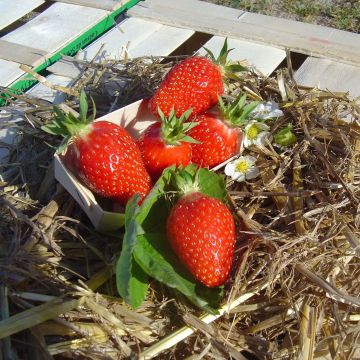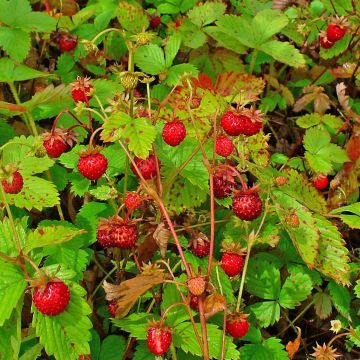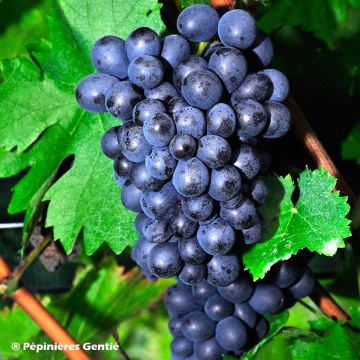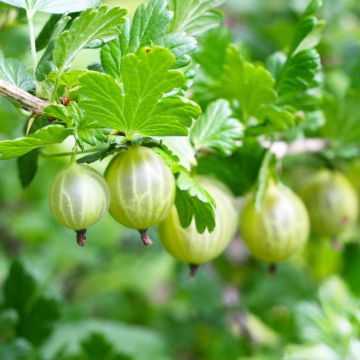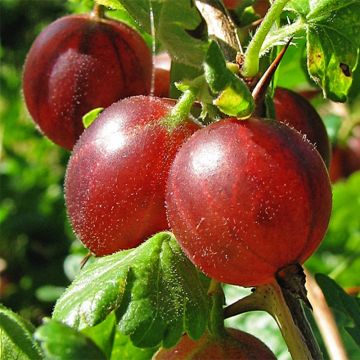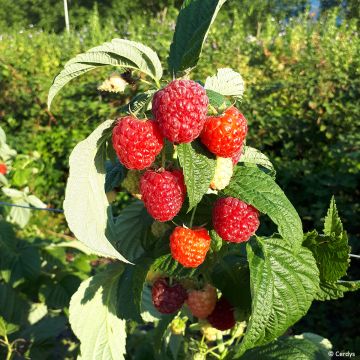

Fragaria Pink Marathon (remontant) - Fraise des bois
Wild Strawberry Pink Marathon (everbearing) - Fragaria x vesca
Fragaria x vesca Pink Marathon
Wild Strawberry, Alpine Strawberry
This item cannot be shipped to the selected country
Delivery charge from €5.90
More information
Schedule delivery date,
and select date in basket
This plant carries a 12 months recovery warranty
More information
We guarantee the quality of our plants for a full growing cycle, and will replace at our expense any plant that fails to recover under normal climatic and planting conditions.
From €5.90 for pickup delivery and €6.90 for home delivery
Express home delivery from €8.90.
Does this plant fit my garden?
Set up your Plantfit profile →
Description
Fragaria vesca 'Pink Marathon' is a lovely, unique, vigorous, and productive alpine strawberry. From spring to the end of summer, this perpetual variety produces clusters of small pink flowers that then transform into small, elongated, red strawberries that are firm, juicy, sweet, and tangy. It likes humus-rich soil, in partial shade or dappled sunlight. It will form smaller, more well-behaved clumps than its wild parent and provide you with a delicious harvest. You can also plant it in a flower pot or hanging basket.
Fragaria vesca belongs to the Rosaceae family, just like many fruit trees (apple, pear, plum, medlar), as well as many ornamental plants, such as roses, avens, and physocarpus. The wild strawberry is found at the edge of many undergrowth areas, where the leaf litter provides a suitable carpet for its establishment. The characteristic leaves are composed of three dark green, toothed leaflets. They are semi-evergreen if the climate is not too cold. Between April and late August, the plants produce a profusion of delicate pink flowers with 5 petals and a yellow central cone. After pollination by insects, they transform into strawberries. From a botanical point of view, strawberries are pseudocarps. The seeds on the strawberry (achenes) are the true fruits, while the red fleshy envelope is just a means for the plant to facilitate their disperal by animals. The 'Pink Marathon' variety produces few stolons. It forms a compact clump, about 30cm (12in) in diameter. However, it is very productive and will delight you with many tasty fruits.
Fragaria 'Pink Marathon' is a hardy plant (down to -25°C (-13°F)), and its production will be better in humus-rich soil that is not too dry. It makes a charming ground cover at the edge of a flower bed or at the edge of woodland. It is easy to grow in a vegetable plot, in a non-scorching exposure. It also works well on patios and balconies.
Report an error about the product description
Flowering
Foliage
Plant habit
Botanical data
Fragaria
x vesca
Pink Marathon
Rosaceae
Wild Strawberry, Alpine Strawberry
Cultivar or hybrid
Other Strawberry plants
Planting and care
Ideally, plant this variety in autumn. Choose a sunny location. It appreciates rich, deep, and well-drained soils that are slightly acidic. A few months before planting, loosen the soil and add a generous amount of well-rotted compost. If your soil is limestone, provide a mulch made of acidic materials (pine needles or bark). Remove weeds and rocks. Strawberry plants are good companions for garlic, beans, lettuce, onions, leeks, thyme, and spinach. However, they do not appreciate the company of cabbage and other brassicas. Strawberry plants remain in place for 3 to 4 years.
In the ground
Space the plants 35cm (14in) apart in all directions. Dig a hole, place the strawberry plant (the collar should be level with the ground), and cover with fine soil. Water thoroughly. If your soil is moist, plant them on mounds 10 to 20cm (4 to 8in) high.
In a pot
Place a layer of gravel or clay balls at the bottom of the pot to facilitate drainage. Fill the pot with a mixture of potting soil, garden soil, and compost. Place the strawberry plant, cover with soil, and firm it down. Water thoroughly.
Regularly weed. Mulch around the plants in summer to maintain soil moisture. Install a protective netting before the fruits turn red to avoid sharing your harvest with birds. You can also place ash or coffee grounds near the young plants to drive away slugs and snails. Water regularly, especially in hot weather. Remove dry leaves in autumn.
Apply compost on the surface in spring. In cool regions, install a tunnel in spring to protect the plants from spring frosts during flowering.
The plants need to be renewed every 3 or 4 years. This variety multiplies through adventive stems, which are small creeping stems that naturally root in the soil, forming new plants. To avoid exhausting the parent plant, cut the adventive stems and replant them if desired.
Wait 4 years before replanting strawberry plants in the same location.
Planting period
Intended location
Care
-
, onOrder confirmed
Reply from on Promesse de fleurs
Berries
Haven't found what you were looking for?
Hardiness is the lowest winter temperature a plant can endure without suffering serious damage or even dying. However, hardiness is affected by location (a sheltered area, such as a patio), protection (winter cover) and soil type (hardiness is improved by well-drained soil).

Photo Sharing Terms & Conditions
In order to encourage gardeners to interact and share their experiences, Promesse de fleurs offers various media enabling content to be uploaded onto its Site - in particular via the ‘Photo sharing’ module.
The User agrees to refrain from:
- Posting any content that is illegal, prejudicial, insulting, racist, inciteful to hatred, revisionist, contrary to public decency, that infringes on privacy or on the privacy rights of third parties, in particular the publicity rights of persons and goods, intellectual property rights, or the right to privacy.
- Submitting content on behalf of a third party;
- Impersonate the identity of a third party and/or publish any personal information about a third party;
In general, the User undertakes to refrain from any unethical behaviour.
All Content (in particular text, comments, files, images, photos, videos, creative works, etc.), which may be subject to property or intellectual property rights, image or other private rights, shall remain the property of the User, subject to the limited rights granted by the terms of the licence granted by Promesse de fleurs as stated below. Users are at liberty to publish or not to publish such Content on the Site, notably via the ‘Photo Sharing’ facility, and accept that this Content shall be made public and freely accessible, notably on the Internet.
Users further acknowledge, undertake to have ,and guarantee that they hold all necessary rights and permissions to publish such material on the Site, in particular with regard to the legislation in force pertaining to any privacy, property, intellectual property, image, or contractual rights, or rights of any other nature. By publishing such Content on the Site, Users acknowledge accepting full liability as publishers of the Content within the meaning of the law, and grant Promesse de fleurs, free of charge, an inclusive, worldwide licence for the said Content for the entire duration of its publication, including all reproduction, representation, up/downloading, displaying, performing, transmission, and storage rights.
Users also grant permission for their name to be linked to the Content and accept that this link may not always be made available.
By engaging in posting material, Users consent to their Content becoming automatically accessible on the Internet, in particular on other sites and/or blogs and/or web pages of the Promesse de fleurs site, including in particular social pages and the Promesse de fleurs catalogue.
Users may secure the removal of entrusted content free of charge by issuing a simple request via our contact form.
The flowering period indicated on our website applies to countries and regions located in USDA zone 8 (France, the United Kingdom, Ireland, the Netherlands, etc.)
It will vary according to where you live:
- In zones 9 to 10 (Italy, Spain, Greece, etc.), flowering will occur about 2 to 4 weeks earlier.
- In zones 6 to 7 (Germany, Poland, Slovenia, and lower mountainous regions), flowering will be delayed by 2 to 3 weeks.
- In zone 5 (Central Europe, Scandinavia), blooming will be delayed by 3 to 5 weeks.
In temperate climates, pruning of spring-flowering shrubs (forsythia, spireas, etc.) should be done just after flowering.
Pruning of summer-flowering shrubs (Indian Lilac, Perovskia, etc.) can be done in winter or spring.
In cold regions as well as with frost-sensitive plants, avoid pruning too early when severe frosts may still occur.
The planting period indicated on our website applies to countries and regions located in USDA zone 8 (France, United Kingdom, Ireland, Netherlands).
It will vary according to where you live:
- In Mediterranean zones (Marseille, Madrid, Milan, etc.), autumn and winter are the best planting periods.
- In continental zones (Strasbourg, Munich, Vienna, etc.), delay planting by 2 to 3 weeks in spring and bring it forward by 2 to 4 weeks in autumn.
- In mountainous regions (the Alps, Pyrenees, Carpathians, etc.), it is best to plant in late spring (May-June) or late summer (August-September).
The harvesting period indicated on our website applies to countries and regions in USDA zone 8 (France, England, Ireland, the Netherlands).
In colder areas (Scandinavia, Poland, Austria...) fruit and vegetable harvests are likely to be delayed by 3-4 weeks.
In warmer areas (Italy, Spain, Greece, etc.), harvesting will probably take place earlier, depending on weather conditions.
The sowing periods indicated on our website apply to countries and regions within USDA Zone 8 (France, UK, Ireland, Netherlands).
In colder areas (Scandinavia, Poland, Austria...), delay any outdoor sowing by 3-4 weeks, or sow under glass.
In warmer climes (Italy, Spain, Greece, etc.), bring outdoor sowing forward by a few weeks.





































